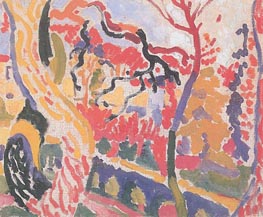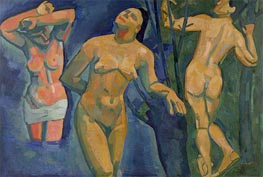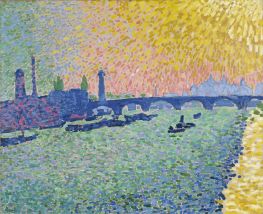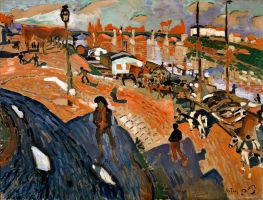
Andre Derain Painting Reproductions 1 of 1
1880-1954
French Fauvist Painter
Andre Derain (June 10, 1880 - September 8, 1954) was a French painter and co-founder of Fauvism with Henri Matisse.
Derain was born in 1880 in Chatou, Yvelines, Ile-de-France, just outside Paris. In 1898, while studying to be an engineer at the Academie Camillo, he attended painting classes under Eugene Carriere, and there met Matisse. In 1900, he met and shared a studio with Maurice de Vlaminck and began to paint his first landscapes. His studies were interrupted from 1901 to 1904 when he was conscripted into the French army. Following his release from service, Matisse persuaded Derain's parents to allow him to abandon his engineering career and devote himself solely to painting; subsequently Derain attended the Academie Julian.
Derain and Matisse worked together through the summer of 1905 in the Mediterranean village of Collioure and later that year displayed their highly innovative paintings at the Salon d'Automne. The vivid, unnatural colors led the critic Louis Vauxcelles to derisively dub their works as les Fauves, or "the wild beasts", marking the start of the Fauvist movement. In March 1906, the noted art dealer Ambroise Vollard sent Derain to London to compose a series of paintings with the city as subject. In 30 paintings (29 of which are still extant), Derain put forth a portrait of London that was radically different from anything done by previous painters of the city such as Whistler or Monet. With bold colors and compositions, Derain painted multiple pictures of the Thames and Tower Bridge. These London paintings remain among his most popular work.
In 1907 art dealer Daniel-Henry Kahnweiler purchased Derain's entire studio, granting Derain financial stability. He experimented with stone sculpture and moved to Montmartre to be near his friend Pablo Picasso and other noted artists. Fernande Olivier, Picasso's mistress at the time, described Derain as:
"Slim, elegant, with a lively colour and enamelled black hair. With an English chic, somewhat striking. Fancy waistcoats, ties in crude colours, red and green. Always a pipe in his mouth, phlegmatic, mocking, cold, an arguer."
At Montmartre, Derain began to shift from the brilliant Fauvist palette to more muted tones, showing the influence of Cubism and Paul Cezanne. Derain supplied woodcuts in primitivist style for an edition of Guillaume Apollinaire's first book of prose, L'enchanteur pourrissant (1909). He displayed works at the Neue Kunstlervereinigung in Munich in 1910, in 1912 at the secessionist Der Blaue Reiter and in 1913 at the seminal Armory Show in New York. He also illustrated a collection of poems by Max Jacob in 1912.
At about this time Derain's work began overtly reflecting his study of the old masters. The role of color was reduced and forms became austere; the years 1911-1914 are sometimes referred to as his gothic period. In 1914 he was mobilized for military service in World War I and until his release in 1919 he would have little time for painting, although in 1916 he provided a set of illustrations for Andre Breton's first book, Mont de Piete.
After the war, Derain won new acclaim as a leader of the renewed classicism then ascendant. With the wildness of his Fauve years far behind, he was admired as an upholder of tradition. In 1919 he designed the ballet La Boutique fantasque for Diaghilev, leader of the Ballets Russes. A major success, it would lead to his creating many ballet designs.
The 1920s marked the height of his success, as he was awarded the Carnegie Prize in 1928 and began to exhibit extensively abroad in London, Berlin, Frankfurt, Dusseldorf, New York City and Cincinnati, Ohio.
During the German occupation of France in World War II, Derain lived primarily in Paris and was much courted by the Germans because he represented the prestige of French culture. Derain accepted an invitation to make an official visit to Germany in 1941, traveling with other French artists to Berlin to attend an exhibition by Nazi sculptor Arno Brecker. The Nazi propaganda machine naturally made much of Derain's presence in Germany, and after the Liberation he was branded a collaborator and ostracized by many former supporters.
A year before his death, he contracted an eye infection from which he never fully recovered. He died in Garches, Hauts-de-Seine, Ile-de-France, France in 1954 when he was struck by a moving vehicle.
Today, paintings by Derain sell for as much as US$6 million. The London paintings were the subject of a major exhibition at the Courtauld Institute in 2005-06.
Derain was born in 1880 in Chatou, Yvelines, Ile-de-France, just outside Paris. In 1898, while studying to be an engineer at the Academie Camillo, he attended painting classes under Eugene Carriere, and there met Matisse. In 1900, he met and shared a studio with Maurice de Vlaminck and began to paint his first landscapes. His studies were interrupted from 1901 to 1904 when he was conscripted into the French army. Following his release from service, Matisse persuaded Derain's parents to allow him to abandon his engineering career and devote himself solely to painting; subsequently Derain attended the Academie Julian.
Derain and Matisse worked together through the summer of 1905 in the Mediterranean village of Collioure and later that year displayed their highly innovative paintings at the Salon d'Automne. The vivid, unnatural colors led the critic Louis Vauxcelles to derisively dub their works as les Fauves, or "the wild beasts", marking the start of the Fauvist movement. In March 1906, the noted art dealer Ambroise Vollard sent Derain to London to compose a series of paintings with the city as subject. In 30 paintings (29 of which are still extant), Derain put forth a portrait of London that was radically different from anything done by previous painters of the city such as Whistler or Monet. With bold colors and compositions, Derain painted multiple pictures of the Thames and Tower Bridge. These London paintings remain among his most popular work.
In 1907 art dealer Daniel-Henry Kahnweiler purchased Derain's entire studio, granting Derain financial stability. He experimented with stone sculpture and moved to Montmartre to be near his friend Pablo Picasso and other noted artists. Fernande Olivier, Picasso's mistress at the time, described Derain as:
"Slim, elegant, with a lively colour and enamelled black hair. With an English chic, somewhat striking. Fancy waistcoats, ties in crude colours, red and green. Always a pipe in his mouth, phlegmatic, mocking, cold, an arguer."
At Montmartre, Derain began to shift from the brilliant Fauvist palette to more muted tones, showing the influence of Cubism and Paul Cezanne. Derain supplied woodcuts in primitivist style for an edition of Guillaume Apollinaire's first book of prose, L'enchanteur pourrissant (1909). He displayed works at the Neue Kunstlervereinigung in Munich in 1910, in 1912 at the secessionist Der Blaue Reiter and in 1913 at the seminal Armory Show in New York. He also illustrated a collection of poems by Max Jacob in 1912.
At about this time Derain's work began overtly reflecting his study of the old masters. The role of color was reduced and forms became austere; the years 1911-1914 are sometimes referred to as his gothic period. In 1914 he was mobilized for military service in World War I and until his release in 1919 he would have little time for painting, although in 1916 he provided a set of illustrations for Andre Breton's first book, Mont de Piete.
After the war, Derain won new acclaim as a leader of the renewed classicism then ascendant. With the wildness of his Fauve years far behind, he was admired as an upholder of tradition. In 1919 he designed the ballet La Boutique fantasque for Diaghilev, leader of the Ballets Russes. A major success, it would lead to his creating many ballet designs.
The 1920s marked the height of his success, as he was awarded the Carnegie Prize in 1928 and began to exhibit extensively abroad in London, Berlin, Frankfurt, Dusseldorf, New York City and Cincinnati, Ohio.
During the German occupation of France in World War II, Derain lived primarily in Paris and was much courted by the Germans because he represented the prestige of French culture. Derain accepted an invitation to make an official visit to Germany in 1941, traveling with other French artists to Berlin to attend an exhibition by Nazi sculptor Arno Brecker. The Nazi propaganda machine naturally made much of Derain's presence in Germany, and after the Liberation he was branded a collaborator and ostracized by many former supporters.
A year before his death, he contracted an eye infection from which he never fully recovered. He died in Garches, Hauts-de-Seine, Ile-de-France, France in 1954 when he was struck by a moving vehicle.
Today, paintings by Derain sell for as much as US$6 million. The London paintings were the subject of a major exhibition at the Courtauld Institute in 2005-06.
4 Andre Derain Paintings

Landscape at Collioure Summer 190
Oil Painting
$182
$182
SKU: DER-3856
Andre Derain
Original Size: unknown
Joanne & Ira Kirshbaum Collection, Los Angeles, USA
Andre Derain
Original Size: unknown
Joanne & Ira Kirshbaum Collection, Los Angeles, USA

Bathers 1907
Oil Painting
$642
$642
SKU: DER-16880
Andre Derain
Original Size: 132 x 195 cm
Museum of Modern Art, New York, USA
Andre Derain
Original Size: 132 x 195 cm
Museum of Modern Art, New York, USA

Waterloo Bridge 1906
Oil Painting
$609
$609
Canvas Print
$60.42
$60.42
SKU: DER-16996
Andre Derain
Original Size: 80.5 x 101 cm
Thyssen-Bornemisza Museum, Madrid, Spain
Andre Derain
Original Size: 80.5 x 101 cm
Thyssen-Bornemisza Museum, Madrid, Spain

The Bridge at Le Pecq c.1904/05
Oil Painting
$844
$844
Canvas Print
$56.64
$56.64
SKU: DER-19703
Andre Derain
Original Size: 88.3 x 115.6 cm
Cincinnati Art Museum, Ohio, USA
Andre Derain
Original Size: 88.3 x 115.6 cm
Cincinnati Art Museum, Ohio, USA